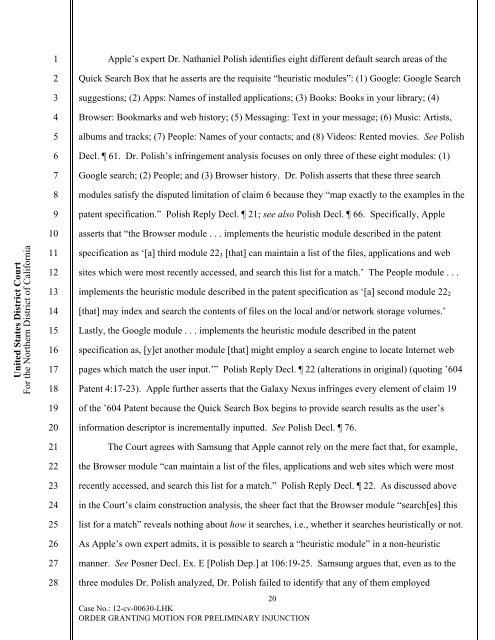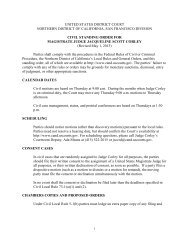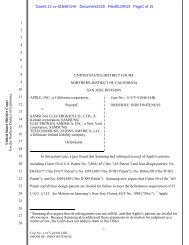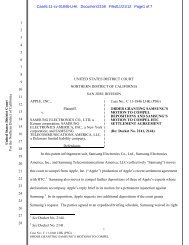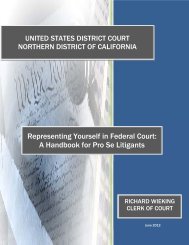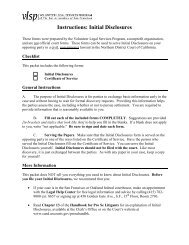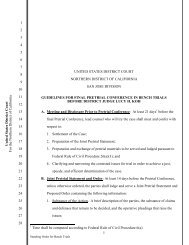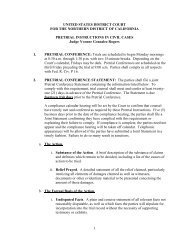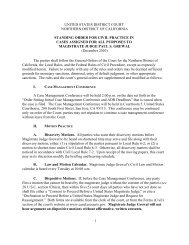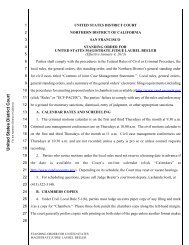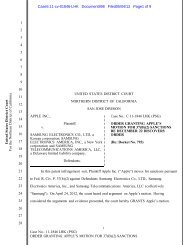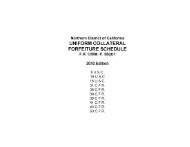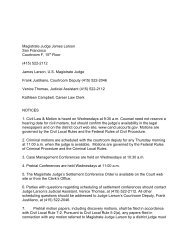Order Granting Motion For Preliminary Injunction - United States ...
Order Granting Motion For Preliminary Injunction - United States ...
Order Granting Motion For Preliminary Injunction - United States ...
You also want an ePaper? Increase the reach of your titles
YUMPU automatically turns print PDFs into web optimized ePapers that Google loves.
<strong>United</strong> <strong>States</strong> District Court<br />
<strong>For</strong> the Northern District of California<br />
1<br />
2<br />
3<br />
4<br />
5<br />
6<br />
7<br />
8<br />
9<br />
10<br />
11<br />
12<br />
13<br />
14<br />
15<br />
16<br />
17<br />
18<br />
19<br />
20<br />
21<br />
22<br />
23<br />
24<br />
25<br />
26<br />
27<br />
28<br />
Apple’s expert Dr. Nathaniel Polish identifies eight different default search areas of the<br />
Quick Search Box that he asserts are the requisite “heuristic modules”: (1) Google: Google Search<br />
suggestions; (2) Apps: Names of installed applications; (3) Books: Books in your library; (4)<br />
Browser: Bookmarks and web history; (5) Messaging: Text in your message; (6) Music: Artists,<br />
albums and tracks; (7) People: Names of your contacts; and (8) Videos: Rented movies. See Polish<br />
Decl. 61. Dr. Polish’s infringement analysis focuses on only three of these eight modules: (1)<br />
Google search; (2) People; and (3) Browser history. Dr. Polish asserts that these three search<br />
modules satisfy the disputed limitation of claim 6 because they “map exactly to the examples in the<br />
patent specification.” Polish Reply Decl. 21; see also Polish Decl. 66. Specifically, Apple<br />
asserts that “the Browser module . . . implements the heuristic module described in the patent<br />
specification as ‘[a] third module 223 [that] can maintain a list of the files, applications and web<br />
sites which were most recently accessed, and search this list for a match.’ The People module . . .<br />
implements the heuristic module described in the patent specification as ‘[a] second module 222<br />
[that] may index and search the contents of files on the local and/or network storage volumes.’<br />
Lastly, the Google module . . . implements the heuristic module described in the patent<br />
specification as, [y]et another module [that] might employ a search engine to locate Internet web<br />
pages which match the user input.’” Polish Reply Decl. 22 (alterations in original) (quoting ’604<br />
Patent 4:17-23). Apple further asserts that the Galaxy Nexus infringes every element of claim 19<br />
of the ’604 Patent because the Quick Search Box begins to provide search results as the user’s<br />
information descriptor is incrementally inputted. See Polish Decl. 76.<br />
The Court agrees with Samsung that Apple cannot rely on the mere fact that, for example,<br />
the Browser module “can maintain a list of the files, applications and web sites which were most<br />
recently accessed, and search this list for a match.” Polish Reply Decl. 22. As discussed above<br />
in the Court’s claim construction analysis, the sheer fact that the Browser module “search[es] this<br />
list for a match” reveals nothing about how it searches, i.e., whether it searches heuristically or not.<br />
As Apple’s own expert admits, it is possible to search a “heuristic module” in a non-heuristic<br />
manner. See Posner Decl. Ex. E [Polish Dep.] at 106:19-25. Samsung argues that, even as to the<br />
three modules Dr. Polish analyzed, Dr. Polish failed to identify that any of them employed<br />
20<br />
Case No.: 12-cv-00630-LHK<br />
ORDER GRANTING MOTION FOR PRELIMINARY INJUNCTION


